Zinus Spa Sensations by Zinus 12″ Green Tea Memory Foam Mattress, California King
The recipe for our #1 best selling mattress? Refreshing green tea, plush-as-a-cotton-ball memory foam and over a decade of experience perfecting mattresses that make sleep a little more wonderful. Our Green Tea Memory Foam Mattress begins with our proprietary green tea and charcoal infused memory foam, because we’re fanatics about finding the sleep-enhancing qualities of natural ingredients. And boy, do these ingredients work! Rich green tea helps keep your mattress fresh as a daisy, and Active Charcoal effectively blocks moisture that would otherwise lead to smelly smells.
- THE RIGHT COMBINATION – Our special recipe for rejuvenating rest? Refreshing green tea and moisture-absorbing Active Charcoal infused into pressure-relieving memory foam that cradles your shape so you awake free of aches and pains and fresh as a daisy
- PRESSURE-RELIEVING FOAMS – 3 inches conforming memory foam, 2 inches soft, airflow enhancing comfort foam, and 7 inches durable, high density base support foam
- Ideal for side sleepers and petite to average weight sleepers
- CERTIPUR US CERTIFIED – Highest quality foam is CertiPUR US Certified for durability, performance, and content
- EXPERTLY PACKAGED – Our technology allows this mattress to be efficiently compressed into one box that’s easily shipped and maneuvered into the bedroom; simply unbox, unroll and this mattress does the rest, expanding to its original shape within 72 hours
- Green tea-infused memory foam with a soft, poly jacquard cover
- Twin mattress supports a maximum weight of 250 lbs, while all other sizes can support up to 500 lbs
- Worry-free 10 year limited warranty included
Additional information
| Material | Fabric |
|---|---|
| Bed Size | California King |
| Mattress Type | Memory Foam Mattresses |
| Mattress Top Type | Tight Top |
| Mattress Thickness | 12 in. |
| Mattress Comfort Level | Plush |
| Features | Mattress-in-a-Box |
| Color | White |
| Assembled Product Weight | 79.81 lb |
| Manufacturer Part Number | OLB-GTFM-12CK |
| Assembled Product Dimensions (L x W x H) | 84.00 x 72.00 x 12.00 Inches |
| Warranty | Worry-free 10 year limited warranty included |






by Banker
We bought this for our two-year-old and she absolutely loves her big girl bed if it’s perfectly in our race car bed that we bought her. We also bought our son a race car bed and bought him the same exact mattress. The mattress is firm, but still soft enough to be comfortable. I have laid in the bed with both of my kids, so I’m aware of how comfortable it is.
by Martha
love it, great pic, would buy again, definitely… very happy.
by Neha
I love sleeping in this mattress
by Ashley
They corrected the mistake and sent me a new mattress. It arrived much more quickly despite that they said they had no expedited shipping option. I’m happy now able to sleep in my new mattress and happy it was corrected. Someone out there got a new mattress for free. Original review:
by Tracy
We slept at an Air BnB on a Zinus mattress and were very impressed! Ours needed replacing and we didn’t give it a second thought. Love it!